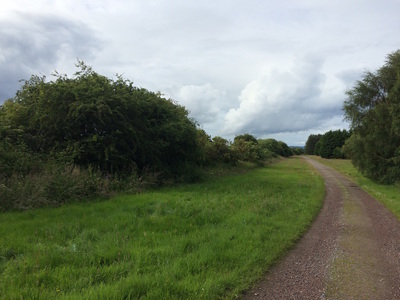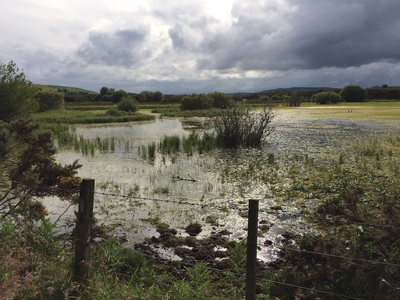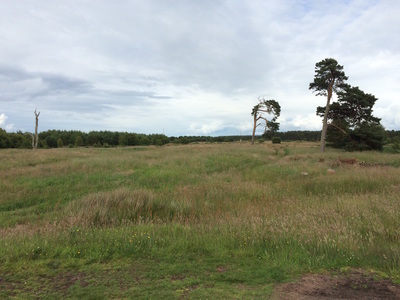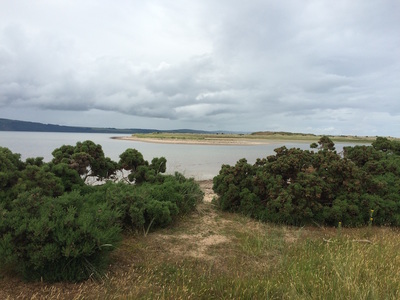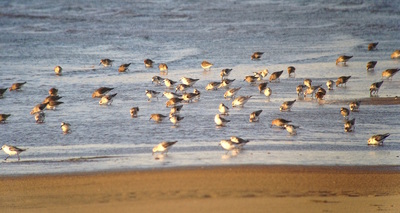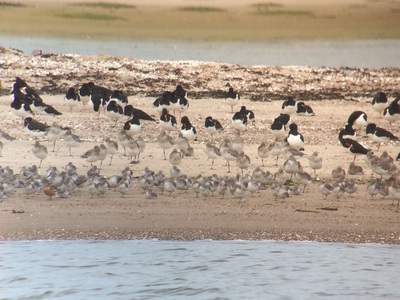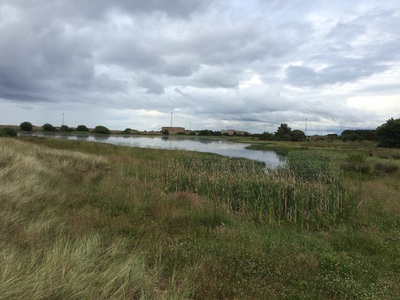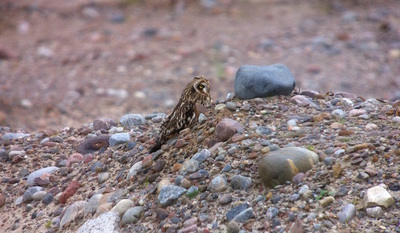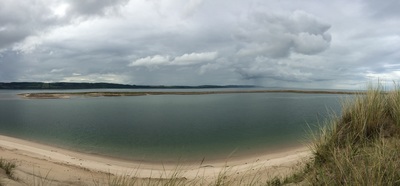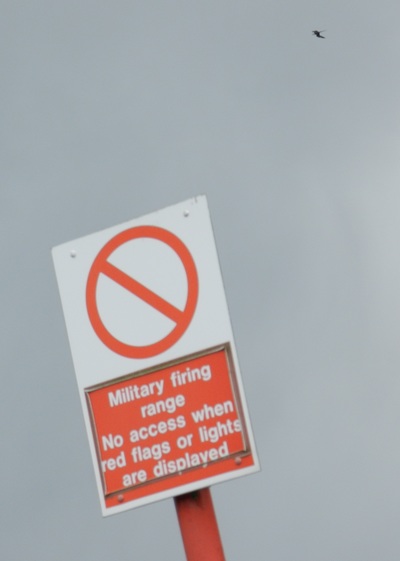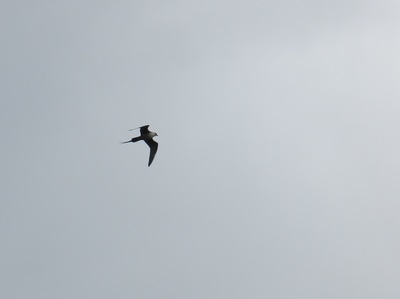Fort George, Whiteness and surrounding area (Written by Jon Clarke)
Consisting of both an abandoned ship building yard and a live MoD firing range Whiteness is never going to win any awards for its scenery, fortunately the birds don't seem to mind.
When I moved to the area a few years ago I began the hunt for a new local patch, the first time I ever visited the site the moment I opened the car door I was greeted by a Quail calling...and so began my interest with Whiteness. Since then despite not being able to visit anywhere near as often as I would like; Great White Egret, King Eider, Hobby, hundreds of Little Auks and Long-tailed Skua passage have been just some of my many highlights so far...
Depending upon the time of year, the weather, the state of the tide how much time I have or what the MoD are up to determines where I go at Whiteness. There is plenty of choice and it would be easy to spend anywhere from an hour to an entire day birding the area.
When I moved to the area a few years ago I began the hunt for a new local patch, the first time I ever visited the site the moment I opened the car door I was greeted by a Quail calling...and so began my interest with Whiteness. Since then despite not being able to visit anywhere near as often as I would like; Great White Egret, King Eider, Hobby, hundreds of Little Auks and Long-tailed Skua passage have been just some of my many highlights so far...
Depending upon the time of year, the weather, the state of the tide how much time I have or what the MoD are up to determines where I go at Whiteness. There is plenty of choice and it would be easy to spend anywhere from an hour to an entire day birding the area.
There are at least five different parking locations I use depending on what my plans are, these are as follows:
(A) Cemetery (NH791557)
(B) MoD Gateway (NH790562)
(C) Woodland track (NH802566)
(D) Fort George car park (NH766567)
(E) Ardersier Bay (NH771566)
Please do not block gateways and note many of these have limited parking and therefore it's not unusual to have to park elsewhere if my first choice is already full.
The cemetery car park (A) is surrounded by some nice farmland where flocks of Linnet and Yellowhammer are common as well as Tree Sparrows. I am reliably informed that Corn Buntings could also be found here in the not too distant past though they seem to have vanished now but I live in hope. In winter geese and swans sometimes use these fields and Golden Plover, Curlew and Lapwing may be encountered here at various times of year. Follow the lane north west until it takes a sharp right hand bend and runs downhill to the road junction and gateway (B) as it does the roadsides transform from fields to scrub which are full of warblers in spring and summer. There is room for a couple of cars to be parked at the gateway (B) which is the entrance to the MoD ground. This is open all year round even when they are using the adjacent firing range. The firing range is also open to the public when not in use, obvious signage and prominent red flags are displayed when it is in use to ensure no confusion.
Follow the track but keep an eye on the hedgerow to your left. This usually holds a good number of common birds, particularly in spring and summer, thrushes, finches, warblers and tits are all common along here, I have also seen Tree Pipit and Spotted Flycatcher using this and I have heard Grasshopper Warbler reeling from the rushy field behind the hedgerow.
(A) Cemetery (NH791557)
(B) MoD Gateway (NH790562)
(C) Woodland track (NH802566)
(D) Fort George car park (NH766567)
(E) Ardersier Bay (NH771566)
Please do not block gateways and note many of these have limited parking and therefore it's not unusual to have to park elsewhere if my first choice is already full.
The cemetery car park (A) is surrounded by some nice farmland where flocks of Linnet and Yellowhammer are common as well as Tree Sparrows. I am reliably informed that Corn Buntings could also be found here in the not too distant past though they seem to have vanished now but I live in hope. In winter geese and swans sometimes use these fields and Golden Plover, Curlew and Lapwing may be encountered here at various times of year. Follow the lane north west until it takes a sharp right hand bend and runs downhill to the road junction and gateway (B) as it does the roadsides transform from fields to scrub which are full of warblers in spring and summer. There is room for a couple of cars to be parked at the gateway (B) which is the entrance to the MoD ground. This is open all year round even when they are using the adjacent firing range. The firing range is also open to the public when not in use, obvious signage and prominent red flags are displayed when it is in use to ensure no confusion.
Follow the track but keep an eye on the hedgerow to your left. This usually holds a good number of common birds, particularly in spring and summer, thrushes, finches, warblers and tits are all common along here, I have also seen Tree Pipit and Spotted Flycatcher using this and I have heard Grasshopper Warbler reeling from the rushy field behind the hedgerow.
Continuing along the track a mature pine plantation on the right holds species you would typically expect to encounter here, Goldcrests, Treecreepers and Coal Tits are all common and with a bit of effort Crested Tits and Common Crossbills can also be found. If it’s woodland birds you are after look at the alternate car park (C) listed further below.
Half way along the plantation the track dissects a pool (NH791568), the wetland to the right adjacent to the plantation is small and full of reeds, but to the left of the track the pool is much larger and more open, surrounded by gorse scrub. The presence of water here means there is normally a good selection of birds attracted to this spot. The afore mentioned woodland species are often concentrated around this spot in the scrub around the smaller pool, but the larger pool to the left can produce Sedge Warblers and Reed Buntings around the periphery and the water itself can hold a mixture of wildfowl in varying numbers depending upon time of year and levels of disturbance. Unfortunately the presence of the invasive plant Crassula helmsi on these pools makes it quite unsuitable for many species particularly later in the summer when it engulfs nearly all of the open water.
Continuing along the track beyond the plantation the area opens out into heathland and birch scrub, a gateway to the left enters the MoD firing range where the habitat also includes a great deal of gorse scrub. Several tracks here cut through and around this area, Lesser Redpoll can usually be found in the birch along with lots of Chiffchaff and Willow Warblers during the summer. Stonechats, Meadow Pipits, Skylarks and Linnets can be found in the open areas of heath, it's also a good place to watch for raptors, Buzzard, Kestrel and Sparrowhawk are all regular but in winter a hunting Hen Harrier is a possibility and during the summer watch for Ospreys flying over to or from the firth.
The heath ends abruptly at the coast (NH794576) at Whiteness bay where a gorse hedge can offer some means of cover to hide behind while scanning the beach. Timing is crucial here as the tide goes a long way out here and with it so do the birds. However if the tide is in then the bay can hold an impressive number and selection of species particularly in spring and late summer when birds are on passage.
Half way along the plantation the track dissects a pool (NH791568), the wetland to the right adjacent to the plantation is small and full of reeds, but to the left of the track the pool is much larger and more open, surrounded by gorse scrub. The presence of water here means there is normally a good selection of birds attracted to this spot. The afore mentioned woodland species are often concentrated around this spot in the scrub around the smaller pool, but the larger pool to the left can produce Sedge Warblers and Reed Buntings around the periphery and the water itself can hold a mixture of wildfowl in varying numbers depending upon time of year and levels of disturbance. Unfortunately the presence of the invasive plant Crassula helmsi on these pools makes it quite unsuitable for many species particularly later in the summer when it engulfs nearly all of the open water.
Continuing along the track beyond the plantation the area opens out into heathland and birch scrub, a gateway to the left enters the MoD firing range where the habitat also includes a great deal of gorse scrub. Several tracks here cut through and around this area, Lesser Redpoll can usually be found in the birch along with lots of Chiffchaff and Willow Warblers during the summer. Stonechats, Meadow Pipits, Skylarks and Linnets can be found in the open areas of heath, it's also a good place to watch for raptors, Buzzard, Kestrel and Sparrowhawk are all regular but in winter a hunting Hen Harrier is a possibility and during the summer watch for Ospreys flying over to or from the firth.
The heath ends abruptly at the coast (NH794576) at Whiteness bay where a gorse hedge can offer some means of cover to hide behind while scanning the beach. Timing is crucial here as the tide goes a long way out here and with it so do the birds. However if the tide is in then the bay can hold an impressive number and selection of species particularly in spring and late summer when birds are on passage.
Dunlin, Ringed Plover, Sanderling, Redshank, Knot, Oystercatcher, Curlew, Bar-tailed Godwit and Turnstone are all fairly standard fare here during passage though small numbers of each of these can usually be found through most of the year with a bit of patience and the winter months hold large flocks of Curlew and Oystercatcher in particular. Other species to be on the look-out for particularly during the passage periods are Grey and Golden Plover, Whimbrel and Greenshank. I have also had Curlew Sandpiper and Little Stint here in the bay on a couple of occasions. With patience and a bit of field craft it is possible to get some crippling views as waders can feed within a couple of meters of a stealthy birder.
During late summer the number of terns can really build up as post breeding adults and their young arrive from various colonies around the Moray Firth and beyond. Several hundred can roost here on the small spit at the back of the bay, these comprise mostly of Sandwich, followed by smaller numbers of Common and a few Arctic Tern.
A scan further out here may produce terns and gulls feeding here as well as the odd skua particularly in autumn, there are a few old anti aircraft poles remaining standing upright way out in the bay and during the summer these are often used as perches by ospreys. Shelduck are usually present in and around the bay and during winter the Culbin flock of Pale-bellied Brent Geese regularly venture into this area.
The bay does unfortunately suffer regularly from disturbance both from dog walkers and also off-road bikes. If this is the case the flock will often resettle at Whiteness Head itself at the end of the spit if conditions are suitable for them so this is worth a check, otherwise it is likely the flock will split up and settle at various different roost sites around the nearby coastline.
Beyond the heath but before the old ship building yard starts is a lagoon (NH798578), despite also being infested with crassula it has not yet taken over all of the open water.
During winter a good number of wildfowl can be found on here comprising mainly of Wigeon, Teal, Tufted Ducks, Goldeneye and Whooper Swans but I have seen Scaup and Long-tailed Ducks on here a couple of times. Probably due to wildfowling the birds here are extremely nervous and very easy to flush so avoid standing against to horizon if you want to scan here. During the summer months Coot, Moorhen and Little Grebe all breed on here and the scrub around the edge hold a number of common warbler species while good numbers of hirundines hawk over the water looking for insects. The best birding on the lagoon however is possibly in autumn when more scarce species of wildfowl for the region turn up on passage. Pochard, Gadwall, Shoveler and Pintail are almost annual here during this period which are all decent local birds.
From the lagoon a walk north through the sand dunes or the old yard. Peregrines can sometimes be seen perched on top of a dune or on one of the old lighting rigs. The roofs of the old buildings provide ideal nesting for Herring and Great Black-backed Gulls. In winter watch out for Snow Buntings which sometimes feed here singly or in flocks. There is also a chance of a Merlin zipping past or a Short-eared Owl quartering the dunes.
There is a Sand Martin colony at the north east end of the dunes and the high point (NH799586) just beyond here offers a good panorama across the channel to Whiteness spit itself. I'd suggest birding from here rather than venturing along the spit itself as this offers a good view, especially if you have a scope. The spit is so narrow that it is impossible to walking along it without flushing whatever birds were roosting on it, and during the summer there are of course breeding species on here too susceptible to disturbance, never mind the long walk!.
From this vantage point the same selection of waders can be encountered here as in the bay, especially if they have been flushed from roosting there. The channel usually holds Red-breasted Mergansers and Eiders as well as a few Cormorants and Shags roosting on the spit or on the more distant buoys. The elevated position here also can provide some decent sea watching especially looking beyond the spit over the deeper water. Late summer and a north easterly wind are best when seabird numbers are boosted by that years young. However it’s worth a look any time of year as I've picked up unseasonal Puffins and Velvet Scoters from here in the middle of summer!.
There is another alternative which is to park in the large woodland (C) from here take a walk through the Scots pine plantation here. This is a mature forest and has been well thinned making birding quite easy and species like Crested Tits are regularly encountered here especially if you are familiar with their call. Continuing through this woodland brings you out on the east side of the heath and from here you can meet up with the walk described earlier.
During late summer the number of terns can really build up as post breeding adults and their young arrive from various colonies around the Moray Firth and beyond. Several hundred can roost here on the small spit at the back of the bay, these comprise mostly of Sandwich, followed by smaller numbers of Common and a few Arctic Tern.
A scan further out here may produce terns and gulls feeding here as well as the odd skua particularly in autumn, there are a few old anti aircraft poles remaining standing upright way out in the bay and during the summer these are often used as perches by ospreys. Shelduck are usually present in and around the bay and during winter the Culbin flock of Pale-bellied Brent Geese regularly venture into this area.
The bay does unfortunately suffer regularly from disturbance both from dog walkers and also off-road bikes. If this is the case the flock will often resettle at Whiteness Head itself at the end of the spit if conditions are suitable for them so this is worth a check, otherwise it is likely the flock will split up and settle at various different roost sites around the nearby coastline.
Beyond the heath but before the old ship building yard starts is a lagoon (NH798578), despite also being infested with crassula it has not yet taken over all of the open water.
During winter a good number of wildfowl can be found on here comprising mainly of Wigeon, Teal, Tufted Ducks, Goldeneye and Whooper Swans but I have seen Scaup and Long-tailed Ducks on here a couple of times. Probably due to wildfowling the birds here are extremely nervous and very easy to flush so avoid standing against to horizon if you want to scan here. During the summer months Coot, Moorhen and Little Grebe all breed on here and the scrub around the edge hold a number of common warbler species while good numbers of hirundines hawk over the water looking for insects. The best birding on the lagoon however is possibly in autumn when more scarce species of wildfowl for the region turn up on passage. Pochard, Gadwall, Shoveler and Pintail are almost annual here during this period which are all decent local birds.
From the lagoon a walk north through the sand dunes or the old yard. Peregrines can sometimes be seen perched on top of a dune or on one of the old lighting rigs. The roofs of the old buildings provide ideal nesting for Herring and Great Black-backed Gulls. In winter watch out for Snow Buntings which sometimes feed here singly or in flocks. There is also a chance of a Merlin zipping past or a Short-eared Owl quartering the dunes.
There is a Sand Martin colony at the north east end of the dunes and the high point (NH799586) just beyond here offers a good panorama across the channel to Whiteness spit itself. I'd suggest birding from here rather than venturing along the spit itself as this offers a good view, especially if you have a scope. The spit is so narrow that it is impossible to walking along it without flushing whatever birds were roosting on it, and during the summer there are of course breeding species on here too susceptible to disturbance, never mind the long walk!.
From this vantage point the same selection of waders can be encountered here as in the bay, especially if they have been flushed from roosting there. The channel usually holds Red-breasted Mergansers and Eiders as well as a few Cormorants and Shags roosting on the spit or on the more distant buoys. The elevated position here also can provide some decent sea watching especially looking beyond the spit over the deeper water. Late summer and a north easterly wind are best when seabird numbers are boosted by that years young. However it’s worth a look any time of year as I've picked up unseasonal Puffins and Velvet Scoters from here in the middle of summer!.
There is another alternative which is to park in the large woodland (C) from here take a walk through the Scots pine plantation here. This is a mature forest and has been well thinned making birding quite easy and species like Crested Tits are regularly encountered here especially if you are familiar with their call. Continuing through this woodland brings you out on the east side of the heath and from here you can meet up with the walk described earlier.
Although Whiteness itself provides plenty of good variety and will keep birders occupied for several hours there are a couple of other good spots that are in the wider area which may be worth a try depending upon the time of year and conditions.
Fort George (D) is an active military base situated on the opposite side of the Firth to Chanonry Point and as with Chanonry it can offer some superb sea-watching given its prominent location. The best location is from within the fort itself from the battlements and access is possible all year round but times are limited and there is an entrance fee. However by parking in the fort's car park it is only a short walk to the coast either side of the base and both options offer decent views across the firth but you have to choose which side to watch, either back towards Inverness or into the outer Moray Firth. During the huge influx of little auks in January 2016 this provided some super views with birds flying both overland and close inshore.
Between Fort George and Ardersier is a height restricted gateway (E) where a track leads to a shingle car park. This offers good views across Ardersier bay which can offer a decent variety of waders and wintering wildfowl. For me this location is special for a different reason, during the spring skua passage, if winds force birds up the great glen they inevitably emerge somewhere near Inverness before making their way out of the inner firth. In 2013 there was a large movement and sitting here gave some great views as birds made their way north east. Many of the Long-tailed Skuas actually flew over my head and across the land rather than winding around the fort. Since then I have also watched a Black-throated Diver and a small group of Little Auks taking a short cut over land from this point.
Fort George (D) is an active military base situated on the opposite side of the Firth to Chanonry Point and as with Chanonry it can offer some superb sea-watching given its prominent location. The best location is from within the fort itself from the battlements and access is possible all year round but times are limited and there is an entrance fee. However by parking in the fort's car park it is only a short walk to the coast either side of the base and both options offer decent views across the firth but you have to choose which side to watch, either back towards Inverness or into the outer Moray Firth. During the huge influx of little auks in January 2016 this provided some super views with birds flying both overland and close inshore.
Between Fort George and Ardersier is a height restricted gateway (E) where a track leads to a shingle car park. This offers good views across Ardersier bay which can offer a decent variety of waders and wintering wildfowl. For me this location is special for a different reason, during the spring skua passage, if winds force birds up the great glen they inevitably emerge somewhere near Inverness before making their way out of the inner firth. In 2013 there was a large movement and sitting here gave some great views as birds made their way north east. Many of the Long-tailed Skuas actually flew over my head and across the land rather than winding around the fort. Since then I have also watched a Black-throated Diver and a small group of Little Auks taking a short cut over land from this point.
